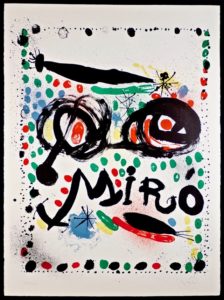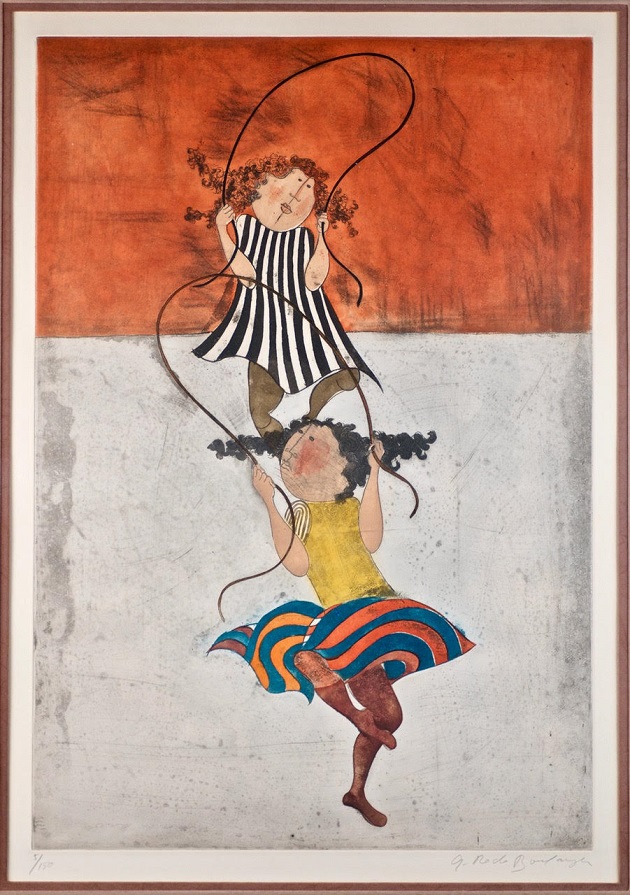What Is Lithography?

“Philadelphia Museum of Art” Limited Edition Lithograph Print hand-signed by Joan Miró
Society has always strived toward artisanal workmanship as well as easy mass production. It is a fine line that is difficult to achieve. Works of fine art can take years to produce, and cheap reproductions have little value. One of the quality printing mediums available to fine artists—that accomplishes both fine artistry and swift reproduction—is lithography. The word “lithograph” comes from two ancient Greek words: “lithos” which means “stones,” and “graphein” which means “to write.” And fine art lithography should not be confused with cheap “offset lithography.” Offset lithography is the high speed, lower quality form of printing intended solely for commercial purposes. If you are a fine art collector, or just want to know more about fine art lithography print-making, here is a brief explanation.
History of Lithography
Lithography, in its simplest form, is the process of print-making using limestone or metal plates plus grease and water. An obscure Bavarian playwright, Alois Senefelder, came across this method through trial and error in 1796 in Germany. Since then, lithography became one of the best methods for widely distributing artwork to the world. Romantic era painters, Impressionists, and Symbolists used it throughout the 19th century to showcase their art. Some of these artists include Théodore Gericault, James McNeill Whistler, and Edgar Degas. At the end of the century, advertisers also used it to create posters, prints, and illustrated books.
Process of Lithography
Lithography begins with a base on which to draw. Limestone was the original material, and continues to be in use in some areas. It retains grease-based mediums like crayons and specially-designed inks, and also receives water readily. Aluminum plates are also used.
In short, this process works on the principle that grease and water repel each other. Once the artist has marked the limestone or metal plate, the lithographer washes the surface with water, and then applies different substances like gum arabic so that some areas will repel ink. Then, the lithographer rolls ink over the surface, applies a piece of paper, and inserts them into a pressing machine. Afterward, the paper will have an imprint of the limestone or metal plate’s drawing. Only one color can mark the paper at a time, so it takes numerous plates to create a complete, multi-color print.

“Two Girls Jumping Rope” Limited Edition Lithograph Print hand-signed by Rodo Boulanger
Highlights of Lithographs
One of the best aspects of lithographs is how fine their detail is. In this sensitive process, the paper captures the pencil strokes and lines accurately, adding almost a living sense of the artwork’s creation. Lithographs are often in black and white, but you can find bright and colorful works as well. Anyone who collects a fine art lithograph has a fine art piece in their hands. One of the major disadvantages of a fine art lithograph print is that colors often have a tendency to fade, particularly due to the very thin layer of ink or pigment applied to the paper’s surface. On the other hand, with serigraphy or silk screen processed fine art prints, the ink layer is generally four to five times thicker than lithography, and serigraphs can be brighter and much more resistant to fading.
Contact Zimmerman Fine Art Today!
Since 1979 Zimmerman Editions Ltd. has worked closely with many internationally acclaimed artists to execute editions of their most unique images. Collaborating directly with the artists, Zimmerman Editions’ atelier has printed, fabricated, and published many special limited editions of fine art, including both prints and sculptures. All images have been faithfully produced to meet the artists’ most exacting requirements. Many of these high-quality art prints and objets d’art are represented in public and private collections around the world.
If you are a fine art dealer or marketer, or interested in collecting contemporary fine art, contact us today through our short form or our number at 888-484-1850. For more about fine art, keep in touch through Facebook, Twitter, and LinkedIn!
